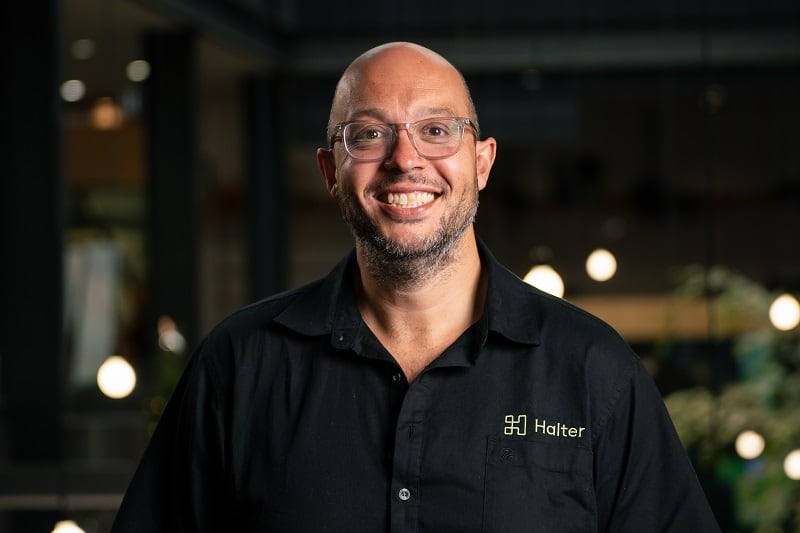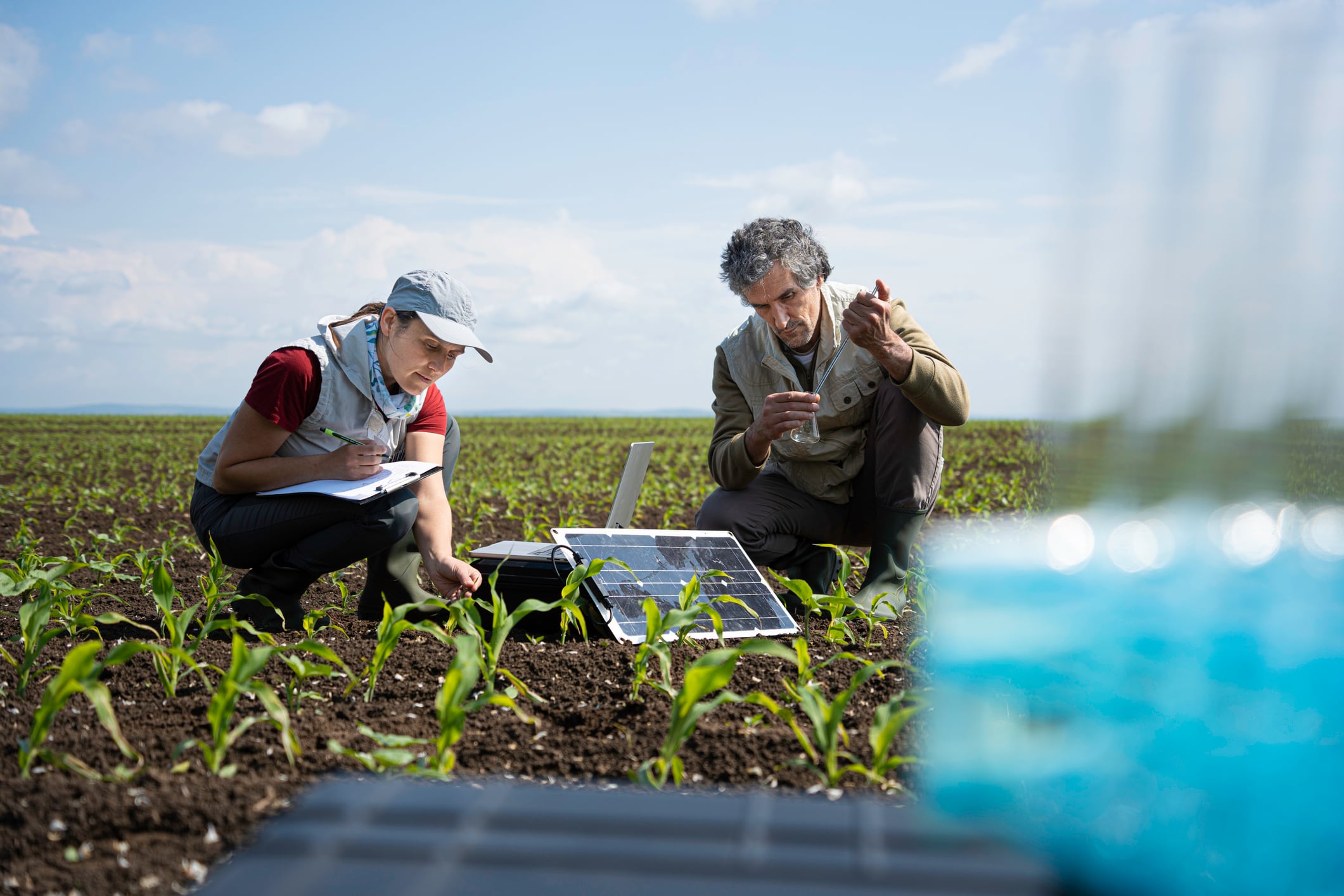ATN: What is Halter?
At our heart, we are a collar for cows that enables a farmer to virtually fence and herd. So from their app they can say: “I want to keep our cows in this break for this period of time.”
You can also say, before you go to bed at night, “I would like our cows to be waiting for us at the dairy shed tomorrow morning at 4:30am for milking.”
ATN: So it’s all about moving cows around the farm?
That’s really just the beginning. We do a lot in terms of reproduction, so mating alerts and heat alerts. The same on the health side of things as well. So noting potential injuries or illnesses or sicknesses.
We’re tracking each cow a minimum of four times a minute: what are they eating? How are they eating? How are they ruminating? Are they resting? Are they moving?
ATN: The idea of a collar for virtual herding isn’t unique. Why is Halter worth $1bn?
We are the only ones in the world that do elements of what we’re doing today. For example, active shifting with directional sound and vibration. So with Halter, the cows train very quickly so if they hear sound in one ear, they turn their head that way. That allows you to get them to a milking shed or between paddocks. That is one pretty unique piece.
Another factor is we’ve got the largest customer base of any virtual fencing company today and we’ve done that off the back of some pretty strong growth. Halter won New Zealand’s Deloitte Fast 50 last year, meaning we were the fastest growing company in New Zealand.
ATN: What is the chief saving from a farmer’s point of view? Why is it good being able to move your cows around virtually?
The biggest thing we talk about is pasture growth. We help farmers grow and graze more pasture. That’s a virtuous cycle. You graze better, that means you grow better. The more grass you make, the more grass a cow grazes, the more milk they produce. Or if it’s beef, the more weight that they gain. So that’s our core piece: increasing a farmer’s revenue.
There are also cost savings associated with that too. One of those is labour. So it’s not saying get rid of a labour unit, but if you do lose a farm worker, you maybe don’t have to replace them straight away.
There’s savings from a vet bill perspective as well. So you’re getting earlier alerts on health issues. And you’re also looking at your reproduction side of things too. So what we typically see is lower empty rates for dairy cows, for example, and tighter bands, which means that there’s more milk that you can get out the other side as well.
You should be paying back Halter just from the pasture gains. But then there’s all these other benefits to it as well, which help make that return on investment stack up.
ATN: What scale are you at now?
We’re operating in three countries right now and we’re on about 400,000 cows from more than 1,000 customers.
ATN: What’s Halter’s business model?
It’s a subscription model. You essentially pay a monthly fee per cow, per collar. You get access to the app as well because obviously the software piece is a critical part of this.
ATN: How much does it cost?
It depends on the package you’re doing, but somewhere in the realm of $5 to $8.
ATN: What are the plans for scaling from here?
The big focus right now is New Zealand, which was our original market. We’re also moving into Australia and the US.
Beyond that, we are looking at new markets. The UK and Ireland is an obvious one for us as it’s very similar to New Zealand in terms of pasture focus and farm sizes.
The other market down the road which is obviously attractive is South America. Brazil has more cows there than anywhere else. Argentina and Uruguay too.

ATN: Why did you go for the series D round now?
A few different things. One is that we were really proud of what we’d been doing. Our growth was going well and so it felt like the right time to make the most of that.
The second one is that we’re investing heavily in our product and engineering side of things and growing the team to make sure that our product continues to be best in class.
And as I mentioned, there’s some new markets that we are actively looking at.
ATN: A lot of the money you raised came from generalist tech investors in Silicon Valley. Was that always the intention, or is that necessitated by the amount of money you were looking to raise?
We’ve always looked at ourselves as an agtech company, but we’re still a tech company at heart. And so that kind of traditional venture capital pathway has made sense.
We’ve always tried to work with the best investors in the world, regardless of whether they are agtech specialists or tech in general. We’ve tried to get the best people to back us, to join our board, to support us in terms of our growth.
ATN: Is the Silicon Valley playbook for venture capital and building companies suitable for agtech?
I think it is. We try and spend a lot of time working with our farmers and ranchers so everything we do is tailored towards them using our app, getting the most out of it, and getting value from their side of things.
It’s a traditional kind of tech process we are driving. So instead of saying, let’s use the agricultural model and tweak it, we’re saying, let’s use the tech model, but then let’s make it really great from an agricultural point of view.
ATN: How much impact does your geographic location make in practice?
It’s a fun one to be honest. I’d say most New Zealand start-ups often try and get out and go overseas as quickly as possible, for things like better access to bigger markets.
We are very lucky when it comes to dairy farming as I would say New Zealand is one of, if not the, best countries in the world for it. And it’s also a really, really big industry here. So it means that we could start here, we could test and we could build.
We are building local teams though. So yes, it’s a long way away. But what we’re trying to do is build out each of those teams with clear ownership for territories or regions that they’re owning, so that you know it doesn’t necessarily feel like you’re partnering with a company whose headquarters is 12 hours away.
ATN: What are the pros and cons of being an agtech firm in New Zealand?
The benefit is a geographical density which you’d also see in the UK and Ireland, but you might not see in Australia or the US. That means you can visit 10 farms in a day, which when you are doing testing or piloting or want to get feedback from customers is really easy.
These are really smart, sophisticated pasture farmers too. They think about pasture a lot, and really push us to make our product as strong as possible.
In terms of drawback, you’d probably just say the distance from other markets. It’s four hours to get anywhere which adds up.



